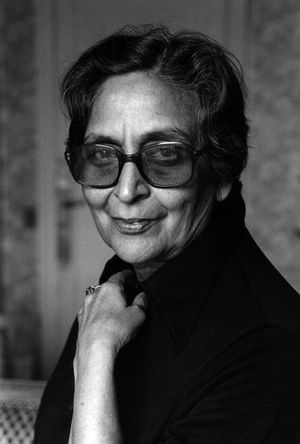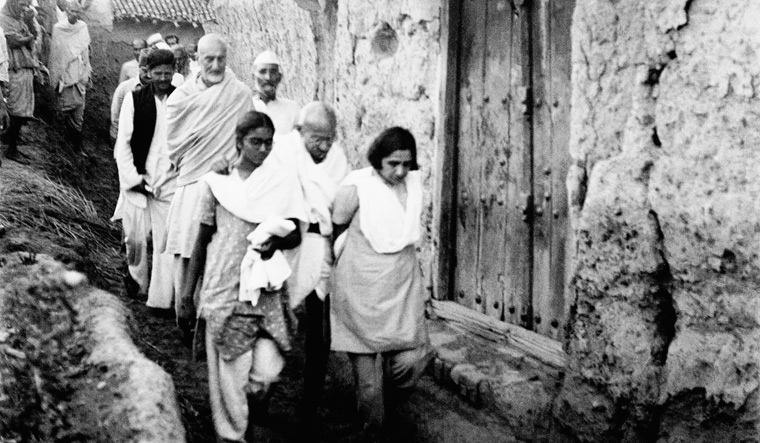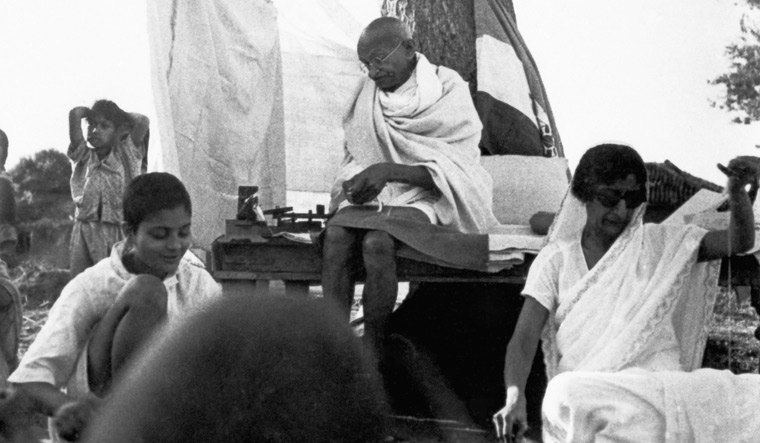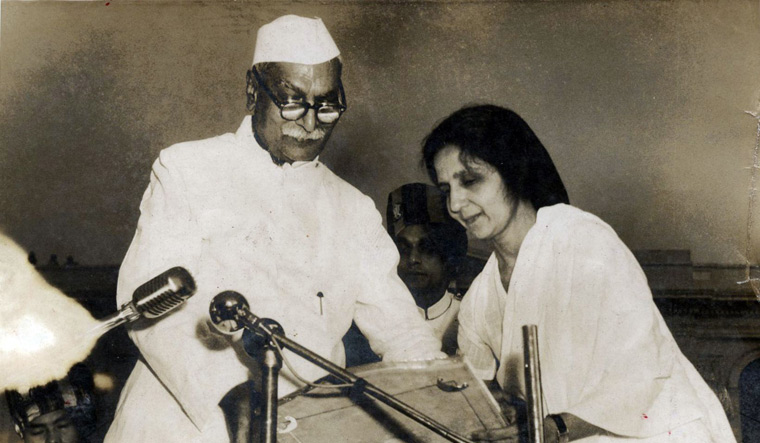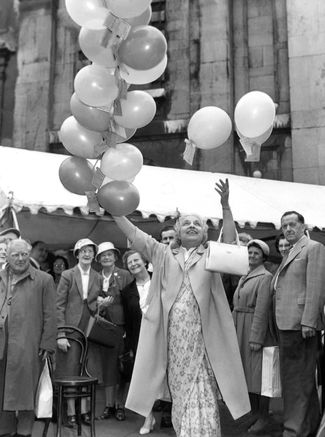Search for Hansa Mehta, and a black-and-white image from May 1946 in New York jumps up. She sits at the edge of a plush sofa, the only woman not in a skirt. Her eyes downcast, Hansa fits the image of the traditional Indian woman, her sari draped neatly and her head covered—not the stereotype of a firebrand committed to fundamental rights, who made space for women to be equal and free. She changed the world, literally, with a word.
On the committee to draft the Universal Declaration of Human Rights for the newly founded United Nations, Hansa is credited with altering the charter to read: all ‘human beings’ are born free and equal. The original sentence said ‘men’ instead of human beings; the shift was revolutionary. Her insistence changed the vocabulary of rights forever. It is a memory that barely exists in India. If it does, it stays firmly in diplomatic circles.
“To me, it was one of the most remarkable contributions of India on the global stage,” said diplomat Syed Akbaruddin, who served as India’s permanent representative to the UN. “She took on at that stage the US and the French constitutions, because the original wording of the Universal Declaration of Human Rights was drawn from the French and the US that all men are equal. For a woman coming from a traditional outlook to make that forward-looking thought, to get it done and push it through, even getting Eleanor Roosevelt, who was the wife of the [former] US president, to approve it, is one of the greatest achievements by India on the world stage.”
Moreover, it was Hansa who officially presented the national flag to the Constituent Assembly for adoption, minutes after the stroke of midnight on August 14-15. The flag was raised on Parliament House next morning. That was the first tricolour officially hoisted in independent India. And, the Constitution would not have been the document it is without the 15 women who were part of the Constituent Assembly.
Much before India’s muscular diplomacy became a concept, there was the quiet power of women who led the way. At a time when India, newly independent, was to establish its credentials, Indian women were at the forefront of global battles for equality and shaping the discourse, and they were here, back home, helping lay the foundations of a democracy which completes 75 years this year.
This is the story of our ‘Midnight’s Daughters’. While many of them, like Sarojini Naidu and Kasturba Gandhi, are household names, there were so many more whose contributions to the country are either forgotten or remembered as mere footnotes or only within certain circles. These Midnight’s Daughters occupied almost every sphere, they even donned uniforms, much before the Indian Army inducted its first women officers. They wrote, they led, they taught and they healed.
Along with Hansa at the UN, there was Lakshmi Menon, a lawyer, who fought for “non-discrimination based on sex’’ in the human rights declaration, as well as Begum Hamid Ali, who was part of the first UN Commission on the Status of Women. Vijaya Lakshmi Pandit became the first woman to serve as the UN General Assembly president. When she was posted to the United Kingdom in 1954 as high commissioner and went to meet prime minister Winston Churchill, he reportedly told her, he did not want her to “put ideas” into heads of other women.
The independence movement was a turning point for women in the country, because it was for the first time that women from “good families” came out in the public, noted writer and critic Rakshanda Jalil. When you see the wives, daughters and sisters of leaders taking part in strikes and resistance—a Sarojini Naidu with Bapu out on the streets—the presence of a woman in a public space no longer becomes taboo.
“This transition from domestic to public is very important,’’ said Ritu Menon, publisher, Women Unlimited. “This distinction is important; it is a watershed moment. These women, with the exception of Mridula Sarabhai, and Qurratulain Hyder, were all married. None of them were a committed public life person. They all had family and other commitments. Nevertheless, they were able to exercise a choice, which was made available to them because of their engagement in this enormous project—first to fight for independence and then, to realise that, in the work they did in the country they became independent.”
In The History of Doing, feminist and author Radha Kumar wrote, “The number of women arrested [during the independence struggle] mounted rapidly. Four hundred women, who were picketing election booths in Bombay, had been so successful that the elections had to be postponed till the next day.” The price was high. Indumati Goenka was given nine months imprisonment for selling khadi door to door. Another got seven months for breaking a prohibitory order. The British retaliation on women was so strong that the Congress compiled a special report on it for its Lahore session in 1931.
“When in response to large-scale prohibitory orders, the Congress issued calls to court arrest, the rush to obey came from women in both urban and rural areas: in 1932-33, Girijabai Manorama Nail and Ambabai Pai from Udipi picketed foreign cloth shops, and courted arrest; Ambabai Kilpadi, a 65-year-old woman from Bantval, and Kamlabai Talchekar, an 18-year-old, were among the dozens of women who courted arrest in South Kanara…,’’ wrote Kumar.
Kamaladevi Chattopadhyay was the first woman to stand for elections in Madras Presidency. She lost, but opened a path for others to win. Post independence, she kept alive the swadeshi dream, documenting and safeguarding textiles and crafts of India.
If Indian women have universal adult franchise today, it is thanks to efforts of women like Muthulakshmi Reddy, whose fight started way before India got independence. One of the early doctors of the country, Reddy’s contribution is multi-faceted. She was the first female legislator in Madras (the second state after Travancore to allow women legislators).
Reddy’s stamp is there on many freedoms Indian women take for granted today. She worked within, as well as outside, the legislature for getting the devadasi system and child marriages abolished. In her book, Lady Doctors, Kavitha Rao wrote that she even took on men like Gandhi, who felt that achieving independence was more important than social reforms at that time. The age of consent was progressively increased. However, it was another doctor, Rukhmabai Raut, whose personal battle to be free of a husband she was married off to as a child resulted in the creation of Age of Consent Act, 1891. She faced criticism from people like Balgangadhar Tilak, but she remained unfazed.
Another of Reddy’s lasting legacies is the Adyar Cancer Institute, which she helped found in memory of a sister she had lost to the disease. On Reddy’s death in 1968, Indira Gandhi said, “Were it not for women like Muthulakshmi Reddy and Dr Sarojini Naidu, we [women] would not be occupying the high positions that we do today.”
Anasuya Sarabhai, hailing from a rich textile family, founded the oldest textile union and became the first woman to lead a mill strike in 1918. Post independence, she continued to be in battle, inspiring, perhaps, one of the most active and defiant women’s groups, SEWA (Self-Employed Women’s Association). Rajkumari Amrit Kaur—“idiot’’ to Gandhi, who signed off as “robber’’ or “tyrant’’ in his letters to her—founded the All India Institute of Medical Sciences. “It has been one of my cherished dreams that for postgraduate study and for the maintenance of high standards of medical education in our country, we should have an institute of this nature which would enable our young men and women to have their postgraduate education in their own country,” she said in her speech to the Rajya Sabha on February 18, 1956.
There was Subhadra Kumari Chauhan, who, while still a teenager, joined Gandhi’s non-cooperation movement. Her pen was her weapon, with which she urged people to fight for independence; poems like ‘Jhansi ki Rani’ and ‘Jallianwala Bagh me vasant (Spring in Jallianwala Bagh)’ have the power to rouse the nationalistic spirit even today. She became a member of the state legislature, though her life was snuffed out in a car accident in 1948. But she, like Rashid Jahan, laid the template on which later writers, who had longer runs in independent India—Ismat Chugtai and Quarratulain Hyder—built on.
Jahan, said Jalil, may be a footnote in literary history, but she pioneered with some daring subjects, speaking about women’s sexuality and reproductive health, for instance. Her work as a doctor allowed her access to homes of both the rich and the poor, and her writings are rich with these experiences. Jahan was a founding member of the Progressive Writers’ Association and Indian People’s Theatre Association.
Chugtai, of course, had a long inning, during which she touched upon issues of sexuality that people were extremely uncomfortable with, such as suggestion of female homosexuality, for which she was even summoned to court for “obscenity”. That was in 1942—clearly, she was much ahead of her times.
Women writers brought the female perspective into the literary domain. Whether it was talk about reproductive and sexual choices, or the impact of large-scale changes, seen through female eyes. Amrita Pritam’s Pinjar touches upon how the blows of partition fell on the woman’s body, Chugtai’s Masooma is about overnight impoverishment due to partition, again from the woman’s perspective.
The first woman to become the chief minister of Uttar Pradesh in independent India, Sucheta Kriplani was instrumental in mobilising women into a political collective. She even famously defied Gandhi to get married to J.B. Kriplani in 1936, a testimony to her strength. She was arrested for a year during the Quit India movement. “It was a very uphill task,” Kriplani acknowledged in an interview. “Thousands of women have participated in the various struggles of the Congress, but women had not been properly organised so far, and there was no women’s organisation, parallel to, or as part of, the Congress’s organisation,” she said in 1974.
Also read
- Tawaifs: unsung warriors of India's independence
- Anuja Chauhan on the dawn of Indian women
- Chanel’s global CEO Leena Nair wears humility and empathy on her sleeve
- The first Indian woman to describe 50 species of frogs
- Falguni Nayar's makeover magic
- 44-year-old woman gives board exams, inspires child brides to join her
Women would come very easily to take part in jail-going programmes, when their husbands, fathers, brothers or sons were arrested. “… but it is difficult to get them for day-to-day political work leaving their domestic responsibilities,’’ she said.
The grand old lady of Quit India movement, Aruna Asaf Ali—beautiful, vocal and a firebrand—managed to straddle two worlds together. Ali, who had sort of disappeared from the political landscape for a decade, re-emerged during Quit India, when she unfurled the flag at Gowalia Tank Maidan (now August Kranti Maidan) in Bombay on August 8, 1942, amid tear-gas and a lathi charge. She went underground to evade arrest—the only leader the British could not capture. Her property was seized by the government and sold. The British put a 05,000 reward for her capture. “She fell ill, and hearing this Gandhi advised her to surrender: ‘I have sent you a message that you must not be underground. You are reduced to a skeleton. Do come out and surrender yourself and win the prize offered for your arrest. Reserve the prize money for the Harijan cause.’ However, Ali surfaced only when the warrants against her were cancelled on the 26th of January, 1946,’’ wrote Kumar in The History of Doing.
At that same flag hoisting was another young girl, Usha Mehta. She was the voice of Bombay’s conscience for many years; Mumbaikars remembered her as the woman who never missed going to Gowalia Tank on the Quit India anniversaries. They knew her as an academician, a Gandhian and a member of Mumbai University’s senate. Once, at a convocation, she spoke about how, in her youth, they used to call the city “bomb, bomb Bombay”, lamenting that the fighting spirit of the city was dying. Coming from a Gandhian, that speech seemed strange, but then, most people had forgotten that she used to run an underground radio station at age 22, coming up with new ways to evade being caught, including jamming the All India Radio, which they termed Anti India Radio. She was finally caught, and spent four gruelling years in jail, including a stint in solitary confinement. Usha’s voice was respected. Atal Bihari Vajpayee, in response to a letter from her, got a play on Nathuram Godse, which was to be staged in Mumbai, called off.
It was befitting that the last public appearance she made was on the anniversary of the Quit India movement in 2000, when she went, as per tradition, to Gowalia Tank, despite being unwell. She died two days later. Partition affected women worse than men, but it brought out more women to the forefront. Mridula Sarabhai, who was part of Gandhi’s vanara sena, took to the streets to stand fiercely in the midst of hate, taking it with all her strength. Integral in helping women rebuild their lives, she was instrumental in recovering abducted women in the aftermath of partition.
“During Gandhi ji’s fast [post independence],” says Ayesha Kidwai, linguist, “thousands of women marched in Old Delhi—many of them who had been raped—for peace. It is admirable.”
It was often those who had lost everything that provided hope. Anis Kidwai was one such woman. Anis’s husband was killed in October 1947 in the communally charged atmosphere. Devastated, Anis rushed to Bapu, who asked her to wipe the tears of those like her. Anis was put in charge of the refugee camps in Humanyun’s Tomb and Purana Qilla. It was in these camps—crammed to the brim with those who witnessed the worst violence—that Anis continued to fight and preserve humanity. “They incorporated the resistance into their humanity,’’ said Kidwai. “We are so caught up in nuance and the weight of history that we feel, we get stuck in believing that they didn’t inherit a baggage of hate. From 1947, they had seen religious violence for 30-40 years... We tend to ignore the role of the state, but it kept fomenting divide after divide. But instead of feeling powerless, they kept trying for 20-25 years. What was courageous of them was that they waded into these pools of hate and stood there firmly and said no.”
Women did not shy away from a fight, either. There were enough of them among the revolutionaries. Kalpana Dutta learned to make bombs when still a student, and took part in the Surya Sen-led Chittagong Armoury Raid. Her teammate Pritilata Waddedar was perhaps the first of the women revolutionaries to consume cyanide to avoid arrest. There was Lakshmi Swaminathan, later Sahgal, who joined Netaji’s Indian National Army (INA) and led the Lakshmibai Regiment. For many of the revolutionaries, social reform was a natural transition. Both women joined the Communist Party subsequently. Datta went back to academia working at Kolkata’s Indian Statistical Institute, but Sahgal remained in the public eye till almost her last years.
There was Durga Bhabhi, wife of revolutionary Bhagwati Charan Vohra, best known as the woman who pretended to be Bhagat Singh’s wife to help him escape. Durga did not think twice before even dragging her young son Sachin into this daring escapade. She may have retired from the public eye after independence, but in her own way, she continued to build the nation, running a school for the poor in Lucknow. She lived till 1999.
It was a battle that these women were committed to—a boundary they continued to push in free India. Hansa not only brought women under the umbrella of human rights, she opened the doors to women in science when she was the vice-chancellor at Baroda University. The first batch was only 15. They were part of debate and discourse within India. Mridula, who had been to jail during independence, found herself labelled a “traitor’’ because she supported Sheikh Abdullah and was imprisoned without trial for months in the Kashmir Conspiracy Case. Pandit, too, might have been Nehru’s sister but found that speaking her mind—especially to her niece Indira Gandhi about the Emergency—had costs.
While Pandit retired to Dehradun, Saghal continued to fight in public. Sahgal was perhaps that rare Midnight’s Daughter who lived well into the new millennium, relevant almost right to the end, fighting valiantly for what most would consider “lost causes”. “She was a person who was always committed to a cause. It mattered little to her whether she was going to see its fruition in her lifetime; it was the cause that was worth fighting for,” recalled her daughter Subhashini Ali. She worked in a clinic for refugees from East Bengal in 1971, led a medical team to Bhopal in 1984 after the gas leak, and led a protest against the Miss World pageant in 1996. She was opposed to the objectification of women, and protested the pageant, keenly aware of its popularity. When everyone else would have retired, she resurrected herself in 2002 to contest against A.P.J. Abdul Kalam for the President’s post, because she felt he should not be elected unopposed.
Right now, when the creative folks are looking to tell the forgotten or untold stories of India’s freedom, Usha Mehta’s story has found appeal with not one, but two filmmakers—both her national award-winner nephew Ketan Mehta and blockbuster maker Karan Johar are planning biopics on her. But there are so many other women, and their stories still need to find a space in the grand independence narrative littered with towering men. It is time to find space for her in the freedom struggle—one that she fought for.




